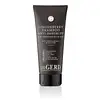What's inside
What's inside
 Key Ingredients
Key Ingredients

No key ingredients
 Benefits
Benefits

 Concerns
Concerns

 Ingredients Side-by-side
Ingredients Side-by-side

Water
Skin ConditioningAloe Barbadensis Leaf Extract
EmollientSodium Coco-Sulfate
CleansingCoco-Glucoside
CleansingGlycerin
HumectantCocamidopropyl Betaine
CleansingSaccharide Isomerate
HumectantSodium Levulinate
Skin ConditioningGuar Hydroxypropyltrimonium Chloride
Skin ConditioningPrunus Amygdalus Dulcis Oil
Skin ConditioningMaris Sal
Skin ConditioningCitric Acid
BufferingSodium Citrate
BufferingPotassium Sorbate
PreservativeWater
Skin ConditioningSodium Coco-Sulfate
CleansingLauryl Glucoside
CleansingSodium Cocoyl Glutamate
CleansingCaprylyl/Capryl Glucoside
CleansingErythritol
HumectantSodium Levulinate
Skin ConditioningSodium Anisate
AntimicrobialGlyceryl Caprylate
EmollientPolyglyceryl-6 Oleate
EmulsifyingSodium Surfactin
CleansingPCA Glyceryl Oleate
EmollientLactic Acid
BufferingMentha Piperita Oil
MaskingAloe Barbadensis Leaf Extract
EmollientPCA Ethyl Cocoyl Arginate
MoisturisingDalburgia Sissoo Extract
Vaccinium Vitis-Idaea Seed Oil
AntioxidantBetula Alba Leaf Water
Skin ConditioningRosmarinus Officinalis Leaf Oil
MaskingCitral
PerfumingGeraniol
PerfumingLimonene
PerfumingLinalool
PerfumingWater, Sodium Coco-Sulfate, Lauryl Glucoside, Sodium Cocoyl Glutamate, Caprylyl/Capryl Glucoside, Erythritol, Sodium Levulinate, Sodium Anisate, Glyceryl Caprylate, Polyglyceryl-6 Oleate, Sodium Surfactin, PCA Glyceryl Oleate, Lactic Acid, Mentha Piperita Oil, Aloe Barbadensis Leaf Extract, PCA Ethyl Cocoyl Arginate, Dalburgia Sissoo Extract, Vaccinium Vitis-Idaea Seed Oil, Betula Alba Leaf Water, Rosmarinus Officinalis Leaf Oil, Citral, Geraniol, Limonene, Linalool
Ingredients Explained
These ingredients are found in both products.
Ingredients higher up in an ingredient list are typically present in a larger amount.
Aloe Barbadensis Leaf Extract is an extract of the leaves of the aloe, Aloe barbadensis, Liliaceae.
Aloe is one of the most well-known natural soothing ingredients, and for good reason. It’s full of water and has a cooling, calming effect on the skin, especially when it’s sunburned, itchy, or irritated. Aloe also helps your skin stay hydrated and smooth by mimicking what healthy skin naturally produces. On top of that, it contains vitamins and nutrients that support skin recovery.
It doesn’t protect you from the sun, but it can help your skin bounce back after too much time in it.
Let’s get into the details:
Aloe contains antioxidant Vitamins A, C, and E, which help fight off free radicals (unstable molecules from things like pollution that can damage your skin).
It’s also rich in polysaccharides, which are natural sugars that help hydrate the skin by acting like the skin’s own moisturizing agents. These, along with other sugars like monosaccharides, help form a protective barrier that locks in moisture.
Aloe works as both a humectant and an emollient. That means it draws water into the skin (humectant) and helps trap it there (emollient), making it an effective natural moisturizer.
You’ll also find a mix of other skin-supporting ingredients in aloe, including folic acid, choline, calcium, amino acids, fatty acids, and even Vitamin B12.
Out of the 420+ species of aloe, Aloe barbadensis is the most widely used in skincare products thanks to its gentle yet effective properties.
There are over 420 species of aloe but Aloe Barbadensis is the most commonly used for topical products.
Learn more about Aloe Barbadensis Leaf ExtractSodium Coco-Sulfate is a type of sulfate.
Sodium levulinate is the a sodium salt of Levulinic Acid. If dissolved in an aqueous solution, the two ingredients become identical.
It is a skin conditioning agent, meaning it helps soften and hydrate your skin.
According to Cosmetic Ingredient Review, the highest amounts of sodium levulinate are found in mouthwashes at 0.62%.
Learn more about Sodium LevulinateWater. It's the most common cosmetic ingredient of all. You'll usually see it at the top of ingredient lists, meaning that it makes up the largest part of the product.
So why is it so popular? Water most often acts as a solvent - this means that it helps dissolve other ingredients into the formulation.
You'll also recognize water as that liquid we all need to stay alive. If you see this, drink a glass of water. Stay hydrated!
Learn more about Water